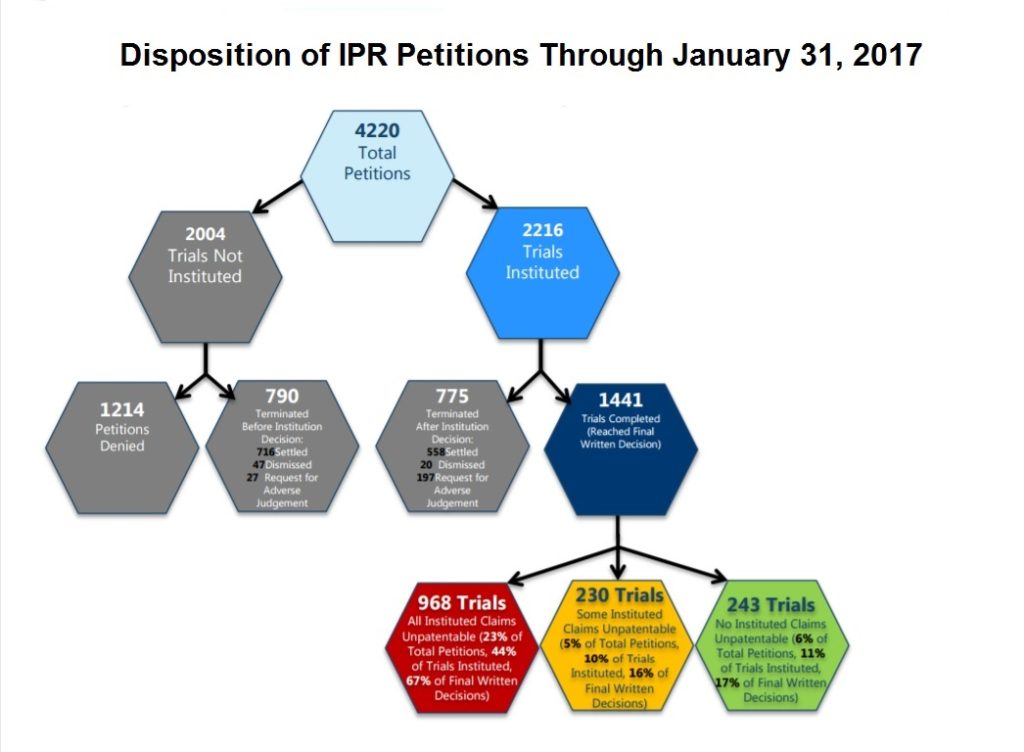In General Plastic Industrial Co., Ltd. v. Canon Kabushiki Kaisha, IPR2016-01357, Paper 19, (September 6, 2017), and IPR2016-01358, IPR2016-01359, IPR2016-01360, and IPR2016-01361, an expanded panel of the PTAB denied reconsideration of the Decision Denying Institution.
Petitioner filed a first set of petitions seeking inter partes review of U.S. Patent No. 9,046,820 and U.S. Patent No. 8,909,094, which were denied based upon the merits. Nine months after the filing of the first set of petitions, Petitioner filed five follow-on petitions, two against the ‘820 patent, and three against the ‘094 patent, all of which were denied pursuant to 35 U.S.C. § 314(a) and 37 C.F.R. § 42.108(a).
In exercising its discretion to deny each of the follow-on petitions, the Board considered the seven NVIDIA factors:
- Whether the same petitioner previously filed a petition directed to the same claims of the same patent;
- Whether at the time of filing of the first petition the petitioner knew of the prior art asserted in the second petition or should have known of it;
- Whether at the time of filing of the second petition the petitioner
already received the patent owner’s preliminary response to the first petition or received the Board’s decision on whether to institute
review in the first petition; - The length of time that elapsed between the time the petitioner learned of the prior art asserted in the second petition and the filing of the second petition;
- Whether the petitioner provides adequate explanation for the time
elapsed between the filings of multiple petitions directed to the same claims of the same patent; - The finite resources of the Board; and
- The requirement under 35 U.S.C. § 316(a)(11) to issue a final
determination not later than 1 year after the date on which the Director notices institution of review
Applying these factors to the follow-on petitions, the Board concluded that the circumstances did not warrant institution of inter partes reviews. As to Factor 1, the Board noted that the same claims of the same patent were at issue in the follow-on petitions as in the denied petitions. As to Factors 2 and 3, the follow-on petitions were all filed nine months
after the filing of the first-filed petitions, and after Patent Owner had filed its Preliminary Responses to the first-filed petitions, and after the Board had denied institution, without any meaningful explanation for the delay. With respect to Factors 4 and 5, Petitioner provided no explanation of any unexpected circumstances that prompted the new prior art searches, or for the delay in doing so. With respect to Factor 6, the Board found that its resources would be more fairly expended on initial petitions, rather than follow-on petitions.
In addition the Board found that that Petitioner had modified its challenges in the follow-on petitions in an attempt to cure the deficiencies that the Board identified in its first-filed petitions, and that this shift tin Petitioner’s challenges was not the consequence of a position that Patent Owner surprisingly advanced or the Board surprisingly adopted. The Board found that the filing of sequential attacks against the same claims, with the opportunity to morph positions along the way, imposes inequities on Patent Owner.
On rehearing the expanded Board rejected the arguments raised by petitioner. The expanded board agreed that there is no per se rule precluding the filing of follow-on petitions, and noted that it has consistently considered a number of factors. The Board recognized that an objective of the AIA is to provide an effective and efficient alternative to district court litigation, but also recognized the potential for abuse of the review process by repeated attacks on patents. The Board said that multiple, staggered petitions challenging the same patent and same claims raise the potential for abuse. The absence of any restrictions on follow-on petitions would allow petitioners the opportunity to strategically stage their prior art and arguments in multiple petitions, using our decisions as a roadmap, until a ground is found that results in the grant of review. This is unfair to patent owners and is an inefficient use of the inter partes review process and other postgrant review processes.
The Board recognized that there may be circumstances where multiple petitions by the same petitioner against the same claims of a patent should be permitted, said that the factors it uses represents a formulation of relevant considerations, and while there may be additional factors, the identified factors are a good baseline. The Board reiterated that institution is committed the this discretion of the Commission, acting through the Board. Reweighing the factors on rehearing, the Board found that six of the seven factors weigh against institution.

